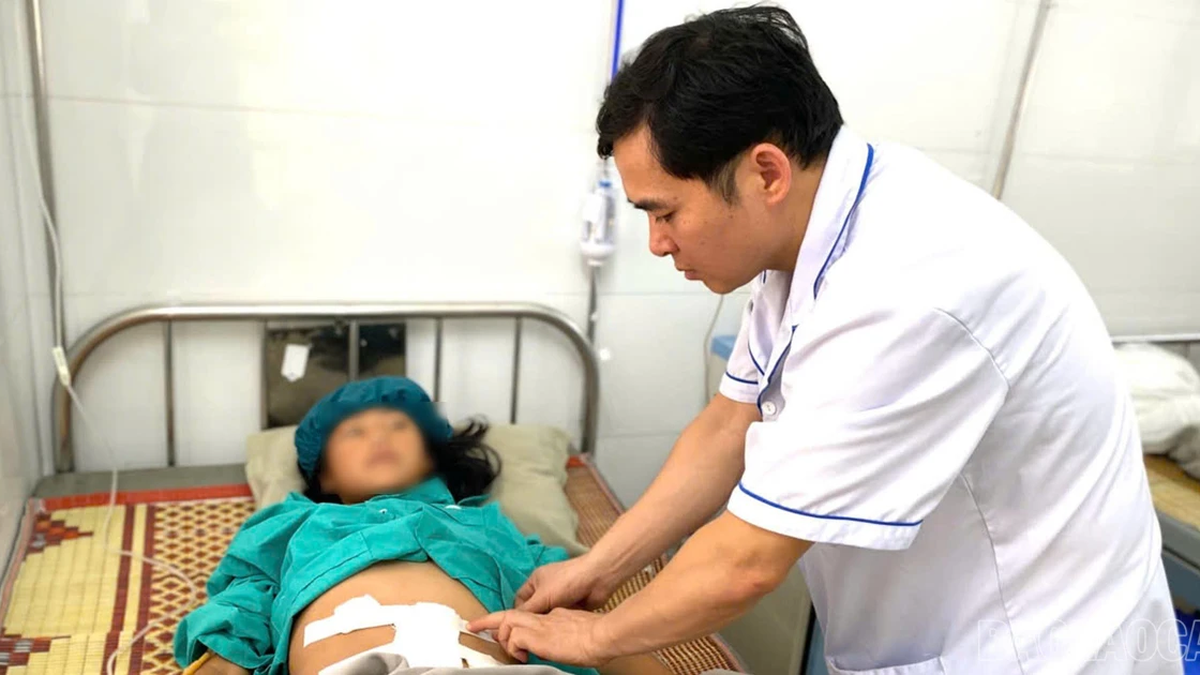The disease progressed severely due to lack of regular check-ups.
The aorta is the large blood vessel that comes from the heart and carries blood throughout the body. The first part of the aorta, called the ascending aorta, is especially important because it carries high blood pressure.
 |
| Doctors recommend that patients should have regular check-ups as prescribed to avoid dangerous health complications. |
Thoracic aortic aneurysm is a condition in which the wall of a blood vessel at a segment is dilated to be 1.5 times larger than the normal diameter, increasing the risk of two dangerous complications: rupture of the aneurysm and dissection of the blood vessel wall, which means the blood vessel layer is torn.
According to Dr. Tran Thuc Khang, who directly treated the patient, if an aortic aneurysm is detected early, the patient can be closely monitored to intervene at the right time, preventing sudden complications. However, Ms. Muong's case shows the consequences of ignoring regular check-ups.
Five years ago, during a general health check-up, Ms. Muong was diagnosed with an ascending aortic aneurysm measuring approximately 47 mm. Although the doctor prescribed medication and scheduled a follow-up visit to monitor the progress of the aneurysm, she was complacent because she had no symptoms and her health was stable, so she did not go for a follow-up visit.
When she came to Tam Anh General Hospital for examination, the doctors recorded that the aneurysm had expanded to more than 55 mm, exceeding the dangerous threshold. Notably, she was also found to have a congenital bicuspid aortic valve (normally the valve has three pieces).
This is one of the causes of aortic aneurysm due to eddy, eccentric blood flow creating abnormal pressure on the vessel wall, leading to long-term dilation and aneurysm.
Although there were no obvious symptoms, with the large size of the aneurysm and the presence of a bicuspid valve and high blood pressure, the doctor prescribed surgery to replace the aneurysm to prevent the risk of sudden rupture.
Dr. Khang said that the damage to the ascending aorta could not be treated with stent placement and required open-chest surgery to replace the damaged vessel with an artificial graft. Fortunately, Ms. Muong's bicuspid aortic valve was still functioning well, so there was no need for valve replacement.
The surgery went well. Doctors removed the aneurysm from the thoracic aorta and replaced it with an artificial blood vessel, keeping the heart valve. Six days after the surgery, Ms. Muong recovered well, the incision healed, her heart functioned stably, and follow-up examinations showed that the graft was working well and the valve was not narrowed or leaky.
Doctor Khang warns that aortic aneurysm is a disease that progresses silently, with no symptoms for many years until serious complications occur.
People with a history of high blood pressure, diabetes, dyslipidemia, smoking, or a family history of genetic diseases such as Marfan syndrome or bicuspid aortic valve malformation... need regular cardiovascular check-ups for early detection and timely treatment.
Complications from using herbal medicine to treat thyroid
After many years of applying leaves and taking traditional medicine to treat goiter, Ms. H. (56 years old, living in Vung Tau) suddenly discovered that the tumor had fallen into the mediastinum, compressing the trachea, threatening her life.
Ms. VTH discovered a tumor in her neck 20 years ago. Although doctors advised her to have surgery soon, she refused because she feared that going under the knife could cause complications, especially loss of voice or endanger her life.
For many years, Ms. H. diligently treated herself with traditional medicine. Twice a week, she took a bus from Vung Tau to Binh Thuan to get herbal medicine, each course costing up to 5 million VND. After half a year without seeing any results, she continued to Dong Thap to find a herbalist to apply leaves in the hope of “dissolving the tumor”. However, after only 30 minutes of applying the medicine, her neck was severely burned and blistered, requiring more than a month of treatment to heal, leaving behind dark scars.
When she could no longer feel the tumor in her neck, Ms. H. was happy to think she was cured without surgery. However, the CT scan results at the hospital made her dizzy as the tumor did not disappear but had sunk deep into the mediastinum, the cavity in the middle of the chest, which contains important organs such as the heart, trachea, large blood vessels, esophagus...
The tumor was nearly a hand span long (about 12 cm), compressing the trachea, causing Ms. H. to feel wheezing every time she lay down. According to Master, Doctor, CKII Doan Minh Trong, oncology specialist, Tam Anh General Hospital, Ho Chi Minh City, this is a case of mediastinal goiter, which is quite dangerous if not intervened promptly.
"The goiter does not disappear but continues to grow and fall into the mediastinum due to many mechanical factors such as gravity, negative pressure in the chest when inhaling, short trachea, large neck, strong neck muscles...", Dr. Trong explained.
Because the tumor has moved deep into the mediastinum, accessing and removing the tumor through a conventional neck incision is extremely difficult. If not done properly, the doctor will be forced to saw the sternum to remove the tumor, a highly invasive technique that causes a lot of pain, high risk of blood loss, nerve damage, post-operative infection, and a long recovery time.
According to experts, mediastinal goiter accounts for about 3% - 20% of all goiter cases, often found in women over 50 years old.
Most tumors are benign, but when they grow large, they can compress the trachea, esophagus, and mediastinal blood vessels, causing difficulty breathing, difficulty swallowing, voice changes, and even acute respiratory failure if not treated promptly.
Surgery is the most effective treatment, helping to completely remove the tumor and significantly improve symptoms.
Doctor Doan Minh Trong warns that there is currently no medical evidence that applying leaves, taking traditional medicine or traditional medicine can reduce goiter. Many patients think that the disease is cured when they can no longer feel the goiter, but in fact the goiter may have moved to the chest, as in the case of Ms. H.
Incorrect treatment not only costs money and effort but also makes the disease worse, causing dangerous complications. When the goiter is too large, surgery will be more difficult and potentially more risky.
Woman with rare diverticulum in esophagus
Ms. Hoang, 66 years old, has lived with bad breath for many years due to a rare Zenker's diverticulum in the esophagus. The 2.5-3 cm diverticulum, which causes food stagnation, was successfully removed by doctors using a modern, minimally invasive endoscopic method.
According to Dr. Do Minh Hung, a digestive specialist, Zenker's diverticulum is a small pouch formed by the esophageal mucosa bulging through a weak point in the muscle, usually at the junction between the pharynx and esophagus.
This is a very rare condition, affecting only 0.01-0.11% of the population. Although benign, diverticula can cause many annoying symptoms and potentially dangerous complications if not treated promptly.
Three years ago, Ms. Hoang accidentally discovered Zenker's diverticulum during a routine endoscopy. Although painless, the diverticulum caused her breath to smell bad due to the food stagnating and decomposing in the pouch. Every few months, she had to go to the hospital for an endoscopy to remove the remaining food, causing inconvenience in her daily life.
Recently, the diverticulum has shown signs of gradually growing larger, reaching 3 cm in size, increasing the risk of complications such as difficulty swallowing, aspiration pneumonia, and choking on food. She decided to go to the hospital for radical intervention.
Dr. Do Minh Hung ordered a chest computed tomography (CT) scan with 1,975 slices to accurately determine the location, size and anatomical relationship of the diverticulum with surrounding organs.
The results showed that the diverticulum was located on the left side of the cervical esophagus, just below the cricoid cartilage, measuring 3 cm, clearly demarcated, and did not invade surrounding fat or tissue. With favorable factors, the patient was indicated for endoscopic surgery through the mouth using a flexible tube using modern techniques.
Previously, Zenker's diverticulum removal was usually performed by open surgery or rigid laparoscopy, which are highly invasive methods that cause postoperative pain and require a long recovery time.
Currently, the third space endoscopy technique is a new step forward. The doctor creates a tunnel under the mucosa, approaches the cricopharyngeal muscle, where the diverticulum is formed, to cut and close it with a clip. This method helps to control well, leaves no scars, reduces pain, has few complications and the patient recovers quickly.
During the endoscopy, the doctor located the diverticulum 15 cm from the upper dental arch. After creating a cavity between the diverticulum mucosa and the esophagus, the doctor used a scalpel to cut the muscle layer that formed the pouch, then closed the opening with 5 clips. The entire process was smooth, without complications.
After surgery, Ms. Hoang had no pain, could walk normally, and was discharged from the hospital after only one day. During the first week, she will eat liquid foods to avoid irritating the intervention area. She is expected to return to normal activities soon after.
Zenker's diverticulum is a slow-growing disease that often has no obvious symptoms in the early stages.
When the size is larger, the patient may have difficulty swallowing, a feeling of choking in the throat, chronic cough, choking when eating, even pneumonia or ulcers, perforated diverticula. The disease mainly occurs in men over 60 years old and is more common in European and North American countries than in Asia.
The cause of Zenker's diverticulum formation is related to a combination of cricopharyngeal muscle dysfunction and a congenital or acquired anatomical weakness, causing the mucosa to be pushed out and form a pouch.
Because the disease cannot be completely prevented, doctors recommend that people, especially the elderly, should have regular health check-ups to detect and treat early, avoiding unfortunate complications.
Source: https://baodautu.vn/tin-moi-y-te-ngay-107-benh-dien-bien-nang-vi-khong-tai-kham-dinh-ky-d327718.html





























































![[Maritime News] More than 80% of global container shipping capacity is in the hands of MSC and major shipping alliances](https://vphoto.vietnam.vn/thumb/402x226/vietnam/resource/IMAGE/2025/7/16/6b4d586c984b4cbf8c5680352b9eaeb0)






































Comment (0)